全文HTML
--> --> -->根据平行光管焦面处靶板的不同, 空间相机MTF检测的常用方法有狭缝法[4-7]、矩形周期靶法[8-10]和刀口靶法[2,3,11-13]. 狭缝法从空间相机采集狭缝像中获取线扩散函数(line spread function, LSF), 对LSF进行傅里叶变换并取模得到MTF. 该方法对狭缝两个刃边的平行度和直线度、狭缝宽度和厚度的加工精度有很高的要求, 且测量结果需要扣除狭缝宽度引入的误差. 矩形周期靶法需根据平行光管焦距、空间相机焦距和探测器像元尺寸, 加工具有特定线宽的矩形周期靶标, 其原理清晰、数据处理量低, 但只能检测特定空间频率处的MTF, 且检测精度易受靶标对比度和对准精度的影响. 刀口靶法只需要加工一条直边, 加工精度要求相对较低, 其尺寸与MTF检测系统和空间相机参数无关. 刀口靶法通过分析刀口靶图像, 得到空间相机的边缘扩散函数(edge spread function, ESF), ESF微分后得到LSF, 对LSF进行傅里叶变换并取模得到MTF. 刀口靶经空间相机成像后通常成缩小像, 导致直刀口法ESF欠采样[11], 需要对刀口进行扫描才能提取相机的ESF[12]. 倾斜刃边法是一种改进刀口靶法, 通过旋转刀口靶使其与空间相机探测器成一定夹角, 再提取过采样ESF, 可以避免直刀口法的ESF欠采样问题[13]. 目前, 倾斜刃边法的主要研究热点为噪声影响分析[12,14,15]、ESF拟合函数模型[2,16-18]和刃边倾角估计[3,19-21]等内容, 以及在多方向MTF同时检测[22]、彩色相机MTF检测[11]等领域的应用研究.
综上, 尚未见空间相机MTF检测时光源光谱特性影响研究的文献报道, 而平行光管光学系统透过率、被测相机光学系统透过率和色差、探测器光谱响应等均存在特定的光谱分布特征, 导致采用不同光谱分布特征的光源检测MTF时会引入测试误差, 降低检测精度. 比如分别采用卤钨灯和氙灯作为光源检测某空间相机MTF时, Nyquist频率处MTF的差异可达0.03. 此外, 空间相机光学系统设计时, 一般根据成像目标的光谱特征来设置空间相机工作波长的权重, 而检测MTF时所用光源通常会偏离光学设计时的光谱分布特征, 导致MTF检测结果偏离理论设计值. 因此, 研究评估光源光谱特性对空间相机MTF影响的方法具有重要意义.
本文推导了光源光谱特性对空间相机MTF影响的理论模型, 给出了空间相机MTF检测系统的组成, 设计了空间相机MTF检测系统光谱响应率和空间相机光学系统单色PSF标定装置及方法, 并通过实验进行了验证. 本文方法刻画了光源光谱特性影响空间相机MTF检测精度的机理, 能够准确评估光源光谱特性对空间相机MTF的影响.
2.1.空间相机MTF检测系统组成
空间相机MTF检测系统组成如图1所示, 主要包括积分球光源、靶板、平行光管和空间相机. 积分球光源位于平行光管焦面后方, 其输出非相干光均匀照明位于平行光管焦面处的靶板处, 经平行光管准直后出射平行光, 模拟无穷远目标. 空间相机对靶板成像, 通过分析靶板图像检测空间相机MTF. 目前, 空间相机MTF检测时, 常用光源包括钨丝灯、氙灯等光源, 其中钨丝灯应用较多, 但其色温偏低, 而氙灯光谱色温则更接近太阳光. 本文重点研究光源光谱特性对MTF检测的影响. 图 1 空间相机MTF检测系统组成
图 1 空间相机MTF检测系统组成Figure1. Configuration of a space camera MTF measurement system.
2
2.2.空间相机MTF检测系统成像模型
一般情况下, 空间相机可以近似为线性移不变系统, 当采用非相干光源照明时, 空间相机MTF检测系统可按如下成像模型表征:







公式(1)中的PSF为整个空间相机MTF检测系统光学部分的PSF, 包括平行光管和空间相机光学系统两部分, 可以按下式表示:


通常, 平行光管像差经严格校正后, 其波像差RMS一般要求全视场优于



2
2.3.光源光谱特性影响建模
空间相机MTF检测系统中与光谱特性相关的因素包括光源、平行光管透过率(或反射率)、空间相机光学系统透过率(或反射率)、空间相机探测器量子效率等. 此时, 平行光管焦面处靶板应引入光源光谱能量分布特征:




通常, 整套检测系统的PSF也具有光谱特性, 即不同波长的PSF由于系统透过率、像差特性的不同而具有不同的函数形式, 按下式表示:








此外, 空间相机探测器量子效率也具有光谱特性, 利用公式(4)可得单色非相干光源照明时空间相机MTF检测系统的成像方程:


将公式(7)和公式(8)带入公式(9)并展开, 整理可得


对空间相机探测器在整个波段范围内各个波长的响应值进行积分, 即可得到其实际采集图像的灰度值:


从上面分析可知, 考虑光源光谱特性、空间相机MTF检测系统光谱响应率后, 系统的本征函数为
2
2.4.光源光谱特性相关参数的标定原理
公示(12)表明, 光源能量分布、空间相机MTF检测系统光谱响应率、空间相机单色PSF随波长变化, 是MTF检测结果受光源光谱特性影响的根本原因. 因此, 前述各因素经标定后, 即可定量研究光源光谱特性对MTF检测结果的影响.光源能量分布可以直接用光谱辐射度计进行标定. 空间相机MTF检测系统的光谱响应率标定原理如图2所示. 整套标定系统由单色仪、光谱辐射度计、积分球、平行光管和空间相机组成. 平行光管焦面处放置星点板, 选取直径较大的星点板, 使空间相机对其成面目标像. 空间相机MTF检测系统光谱响应率标定时, 空间相机已完成光电对接, 光谱响应率的具体标定步骤如下:
 图 2 空间相机MTF检测系统光谱响应率标定原理图
图 2 空间相机MTF检测系统光谱响应率标定原理图Figure2. Schematic of calibrating the spectral response of the space camera MTF measurement system.
Step1 平行光管焦面后方放置积分球, 积分球侧面有两个小孔, 用于安装单色仪出射光纤和光谱辐射度计探头, 空间相机位于平行光管出光口正前方.
Step2 平行光管焦面处安装星点板, 调整空间相机位置, 使其所成星点板图像位于空间相机探测器靶面中心.
Step3 将空间相机工作波段进行等分, 得到多个波长位置



Step4 按下式计算整套空间相机MTF检测系统的归一化光谱响应率:


空间相机光学系统单色PSF标定原理如图3所示, 整套标定系统包括单色仪、平行光管、空间相机光学系统和显微测量系统. 显微测量系统由显微物镜、中继镜和探测器组成. 平行光管焦面处放置星点板, 其直径

 图 3 空间相机光学系统单色PSF标定原理图
图 3 空间相机光学系统单色PSF标定原理图Figure3. Schematic of calibrating the monochrome PSF of the optical system of a space camera.



空间相机光学系统单色PSF的具体标定步骤如下:
Step1 将单色仪置于平行光管焦面后方, 空间相机光学系统固定于平行光管和显微测量系统之间, 平行光管焦面处放置鉴别率板;
Step2 调整平行光管、空间相机光学系统和显微测量系统之间的位置关系, 使三者光轴平行;
Step3 调整显微测量系统位置, 使其对鉴别率板成像最清晰, 此时, 将鉴别率板更换为星点板;
Step4 按光谱响应率标定时的波长位置, 控制单色仪依次输出相应波长的单色光, 利用显微测量系统采集并存储空间相机光学系统的单色PSF.
3.1.空间相机MTF检测系统光谱特性相关参数标定
33.1.1.光谱响应率标定
空间相机MTF检测系统光谱响应率标定实验中, 平行光管为离轴三反结构, 其焦距为5000 mm, F数为10, 焦面处安装直径为1 mm的星点板. 实验用空间相机由Sigma镜头和Cannon EOS 5D SR相机组成, Sigma镜头焦距为1000 mm, F数为5.6, Cannon EOS 5D SR相机的像元尺寸为4.14 μm. 实验中采用纽比特公司的Omno30300型单色仪, 其输出单色光经光纤导入积分球开口处. 将美国ASD公司的FieldSpec型光谱辐射度计的探头(10度探头)固定在积分球另一开口处, 采集光谱福亮度.单色仪在空间相机工作波段(375—750 nm)内每隔5 nm输出单色光, 光谱辐射度计采集单色仪输出光的光谱福亮度, 空间相机采集星点板图像, 然后按照2.4节中的相关步骤标定空间相机MTF检测系统光谱响应率. 空间相机MTF检测系统光谱响应率标定结果如图4所示. 从图4中可以看出, 该相机工作波段为可见光波段, 在400—700 nm, 光谱响应率峰值在570 nm附近.
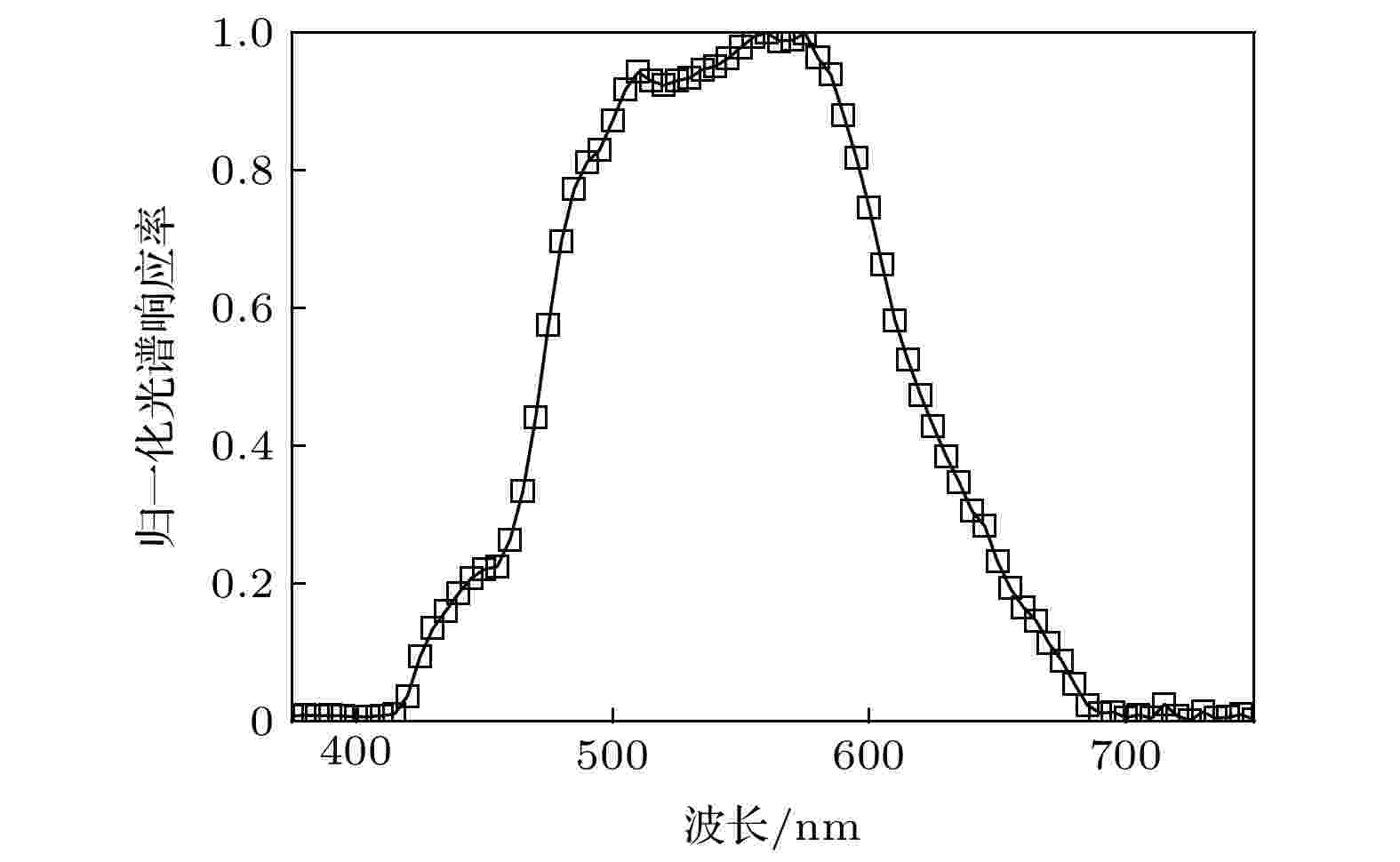 图 4 空间相机MTF检测系统光谱响应标定结果
图 4 空间相机MTF检测系统光谱响应标定结果Figure4. Calibration results of the spectral response of the space camera MTF measurement system.
3
3.1.2.光源光谱特性标定
根据公式(12)可知, 光源的输出光谱相当于计算MTF时各单色PSF的叠加系数. 因此, 采用不同的光源会得到不同的MTF检测结果, 这正是本文重点研究的内容. 为验证光源光谱特性对MTF检测结果的影响程度, 选用Labsphere卤钨灯光源和氙灯光源各一台, 并采用光谱辐射度计标定其光谱特性. 此外, 查阅了Thorlabs宽带卤素光纤照明光源、稳定型红外钨光源和稳定型卤钨光源的光谱输出数据. 前述光源的输出光谱如图5所示, 从图5中可以看出, 在空间相机工作波段范围内, 卤钨灯、宽带卤素光纤照明光源、稳定型红外钨光源和稳定型卤钨光源的光谱福亮度在短波附近较弱, 向长波方向近似线性增加. 卤钨灯、宽带卤素光纤照明光源和稳定型卤钨光源的谱型相近, 氙灯在空间相机整个工作波段内的光谱福亮度分布较均匀.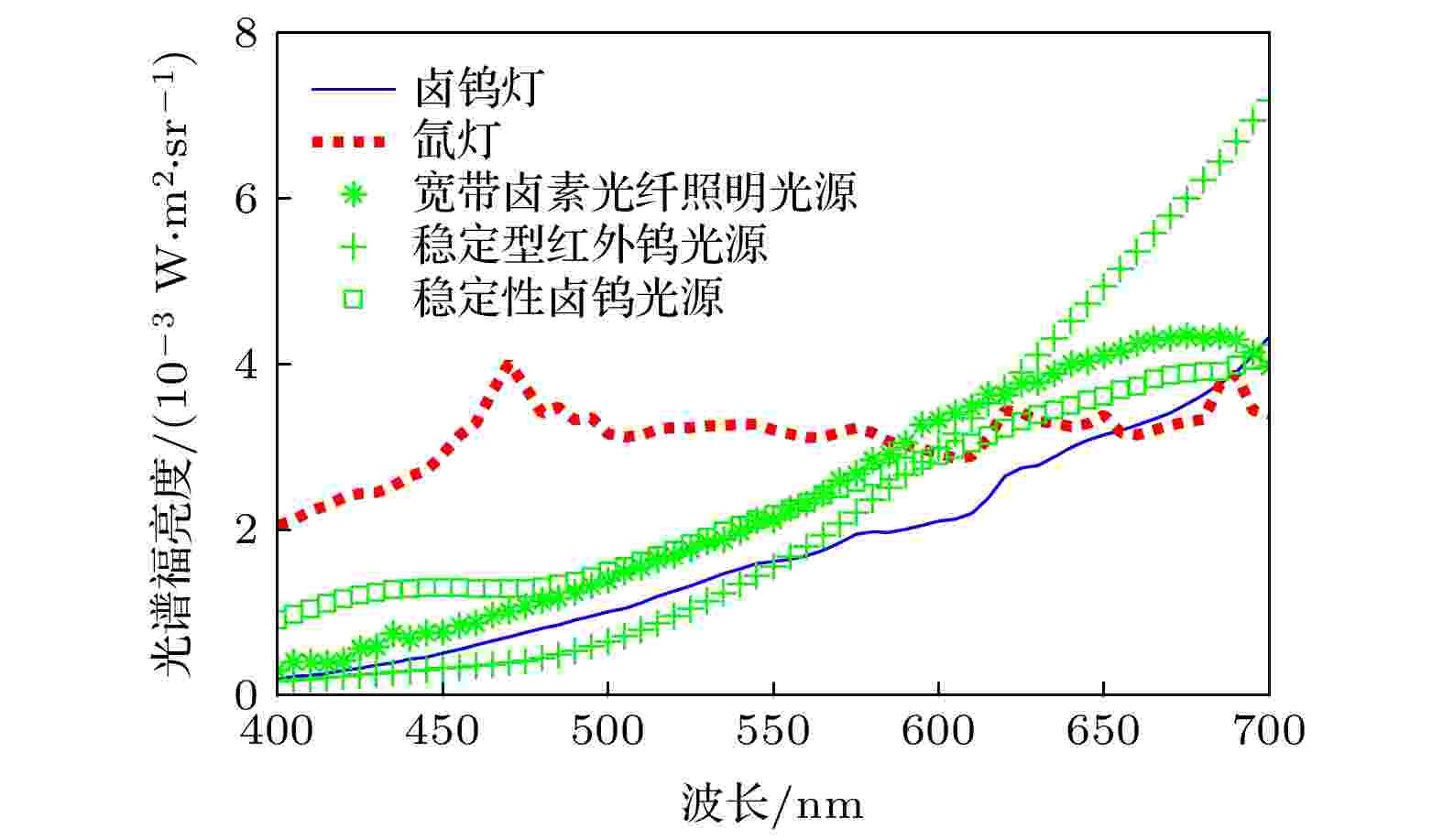 图 5 常用光源光谱特性
图 5 常用光源光谱特性Figure5. Spectral characteristics of typical light sources.
3
3.1.3.空间相机光学系统单色PSF标定
空间相机光学系统单色PSF标定实验中, 平行光管焦面处安装0.02 mm直径星点板. 将两个移动方向互相垂直的平移台固定于剪切架上, 构建三维调节装置, 显微测量系统固定于该装置上. 显微测量系统采用Olympus显微物镜, 数值孔径为0.45, 放大倍率为20 X. 显微测量系统中继镜放大倍率为1, 采用Princeton Instruments的PIXIS 1024型探测器采集图像, 像元尺寸为13 μm. 因此, 显微测量系统所采集图像中单个像元的真实尺寸为0.65 μm, 据此可以计算空间相机光学系统单色PSF的弥散斑直径.在400—700 nm波段, 控制单色仪每隔5 nm输出单色光, 按照2.4节中的相应步骤标定空间相机光学系统单色PSF. 图6所示为450, 500, 550, 600, 650和700 nm处空间相机光学系统单色PSF的标定结果. 从图6可以看出, 该光学系统短波处PSF的直径大, 而中长波处PSF弥散较小, 存在明显的色差, 这加剧了光源光谱特性对空间相机MTF检测结果的影响.
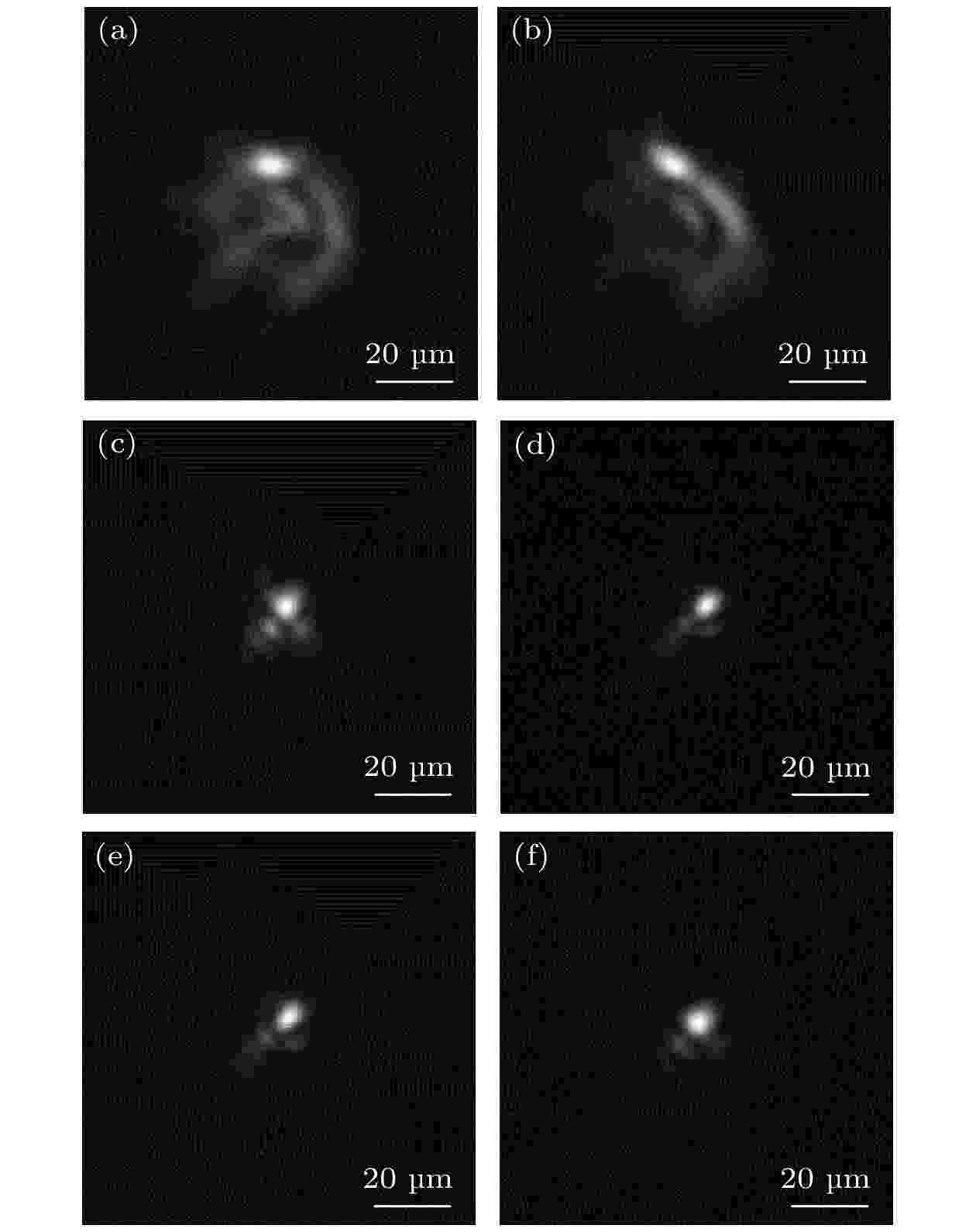 图 6 空间相机光学系统多个波长处的单色PSF (a) 450 nm; (b) 500 nm; (c) 550 nm; (d) 600 nm; (e) 650 nm; (f) 700 nm
图 6 空间相机光学系统多个波长处的单色PSF (a) 450 nm; (b) 500 nm; (c) 550 nm; (d) 600 nm; (e) 650 nm; (f) 700 nmFigure6. Monochrome PSF of the optical system of a space camera at: (a) 450 nm; (b) 500 nm; (c) 550 nm; (d) 600 nm; (e) 650 nm; (f) 700 nm.
为表征空间相机光学系统各波长处PSF的差异, 按文献[24]的方法计算空间相机光学系统单色PSF的弥散斑直径, 其随波长变化的情况如图7所示. 从图7中可以看出, 空间相机光学系统短波端弥散斑直径大且随波长变化大, 说明残余像差较大. 长波端弥散斑直径小且基本一致, 像差校正较好. 前述现象与图6所示的趋势一致.
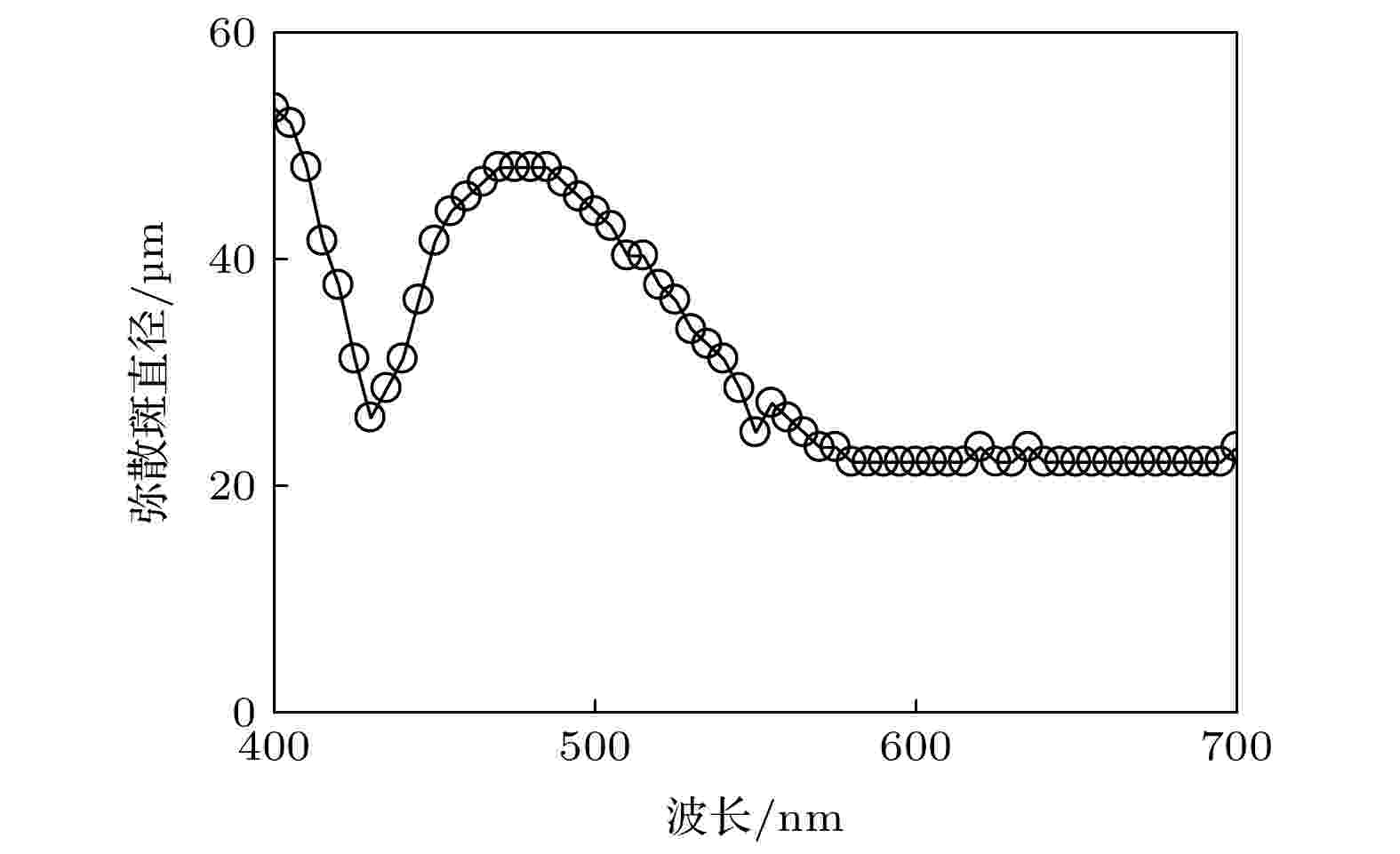 图 7 单色光弥散斑直径随波长变化曲线图
图 7 单色光弥散斑直径随波长变化曲线图Figure7. Diameter of monochrome spot diagrams verse wavelength.
2
3.2.光源光谱特性对MTF检测结果影响的理论计算结果
在完成空间相机MTF检测系统光谱响应率、光源光谱特性和单色PSF标定后, 可以直接根据公式(12)计算采用相应光源时的理论MTF. 为方便计算, 对公式(12)进行整理, 得到式中,



从图6可以看出, 空间相机光学系统各单色PSF的形状复杂, 难以利用数学表达式进行表达. 因此, 本文采用数值方法计算公式(16)中的积分, 利用快速傅里叶变换算法实现傅里叶变换运算:
式中,


用不同光源检测空间相机MTF时的理论值如图8所示. 从图8可以看出, 采用卤钨灯、宽带卤素光纤照明光源和稳定型卤钨光源检测MTF时的理论值几乎一致, 采用稳定型红外钨光源检测MTF时的理论值则偏高. 而采用氙灯光源检测MTF时的理论值明显低于其他光源, 具体表现为在低频段相差较小, 中高频段偏差逐渐增大, 在高频段相对接近.
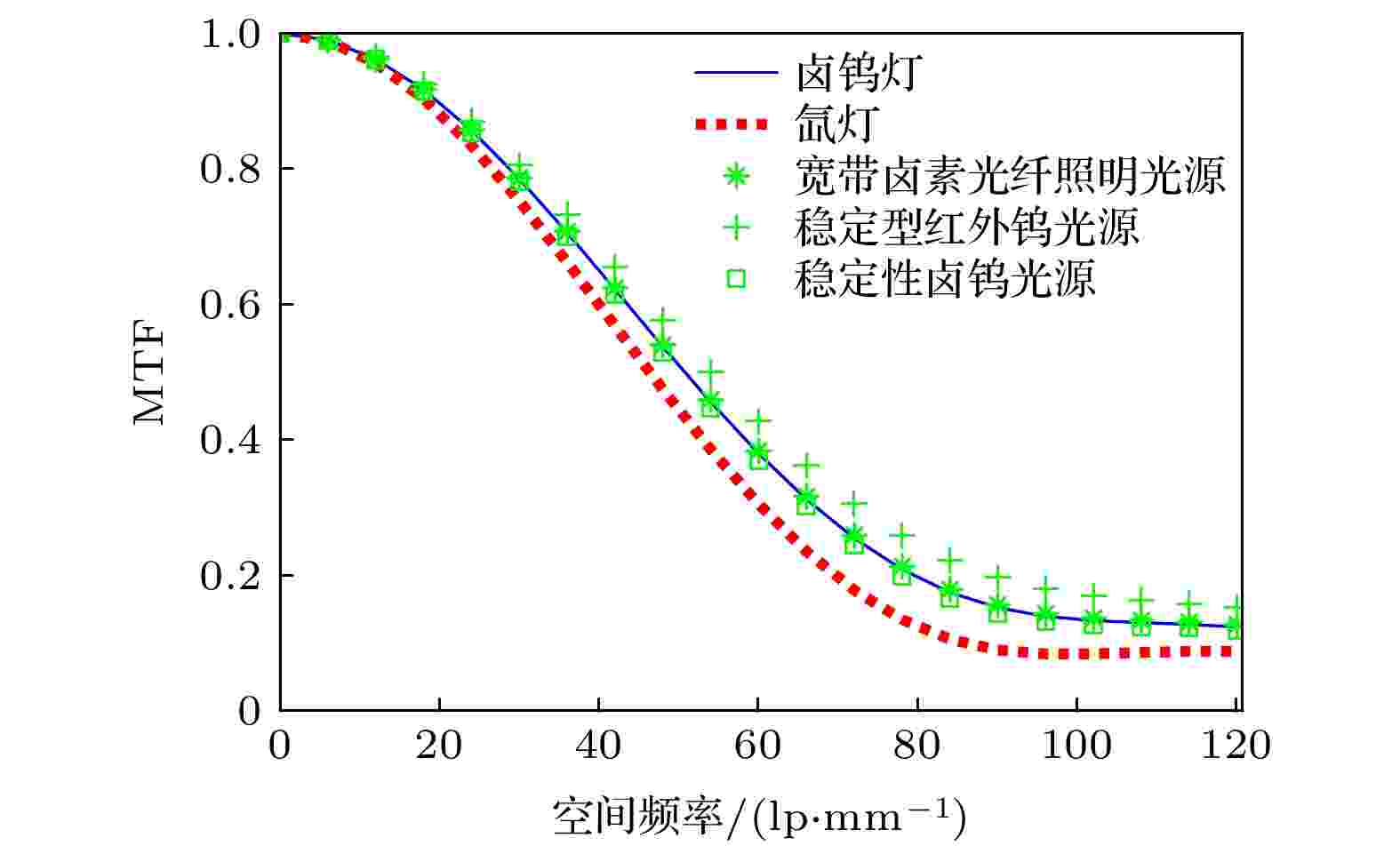 图 8 不同光源对应空间相机MTF理论值
图 8 不同光源对应空间相机MTF理论值Figure8. Theoretical values of the space camera MTF corresponding to different light sources.
从图8可以看出, 采用卤钨灯、宽带卤素光纤照明光源、稳定型红外钨光源和稳定型卤钨光源检测MTF时的理论值相近, 但与采用氙灯检测MTF时的理论值偏差较大. 因此, 表1给出了采用卤钨灯和氙灯时所得MTF在











| 光源 | 不同空间频率处的MTF | |||
| ${f_c}/4$ | ${f_c}/2$ | $3{f_c}/4$ | ${f_c}$ | |
| 卤钨灯 | 0.784 | 0.377 | 0.153 | 0.124 |
| 氙灯 | 0.750 | 0.302 | 0.091 | 0.089 |
| 卤钨灯与氙灯 间MTF偏差 | 0.033 | 0.075 | 0.062 | 0.036 |
表1卤钨灯和氙灯所得MTF理论值及其偏差
Table1.Theoretical values and its deviation between the MTF measured with a tungsten halogen lamp and a xenon lamp.
2
3.3.光源光谱特性对MTF检测结果影响的实验验证
为验证本文方法的有效性, 特进行实验. 正如第1节所述, 倾斜刃边法相较于狭缝法、矩形靶法具有一定优势. 因此, 采用倾斜刃边法来检测空间相机的MTF. 所用实验装置与3.1.1节中光谱响应率标定时的设备相同. 平行光管焦面处安装刀口靶. Cannon EOS 5D SR相机ISO设置为1000, 快门为2000. 开始实验前, 调整空间相机位置, 使其所成刀口像中心与探测器中心重合. 旋转刀口靶, 使其与空间相机探测器列方向成一微小夹角. 分别用卤钨灯和氙灯作为光源, 采集对应的刀口图像. 实验中所采集刀口图像如图9所示.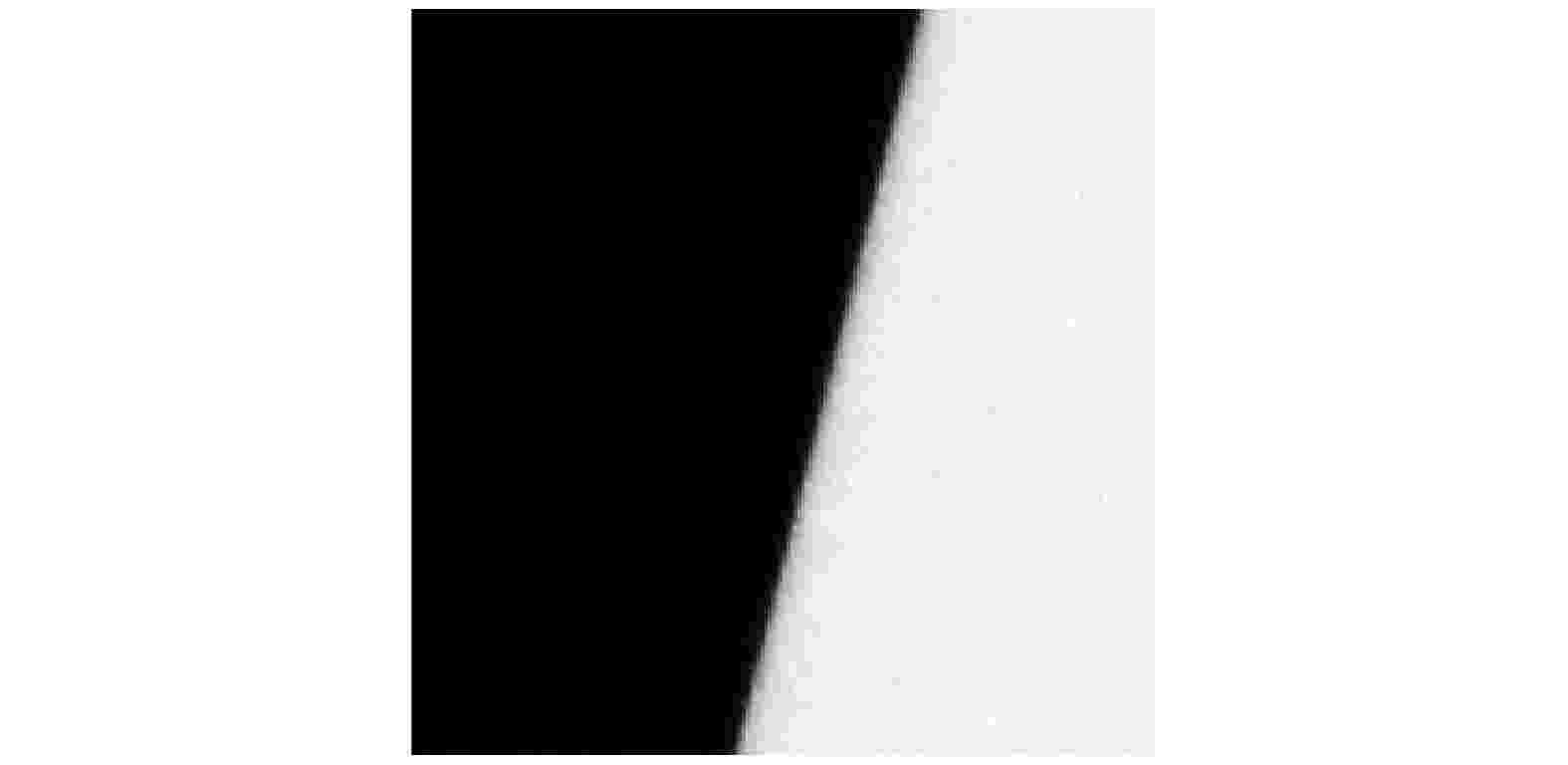 图 9 实验采集的刀口靶图像
图 9 实验采集的刀口靶图像Figure9. Knife-edge image captured in the experiment.
利用倾斜刃边法处理实验中所采集刀口图像, 得到卤钨灯和氙灯作为光源时空间相机MTF的检测结果(图10). 从图10可以看出, 在全频段内, 采用卤钨灯光源时所得MTF检测结果均大于采用氙灯光源作为光源时所得MTF检测结果, 其低频和高频处偏差相对较小, 中高频处二者偏差较大.
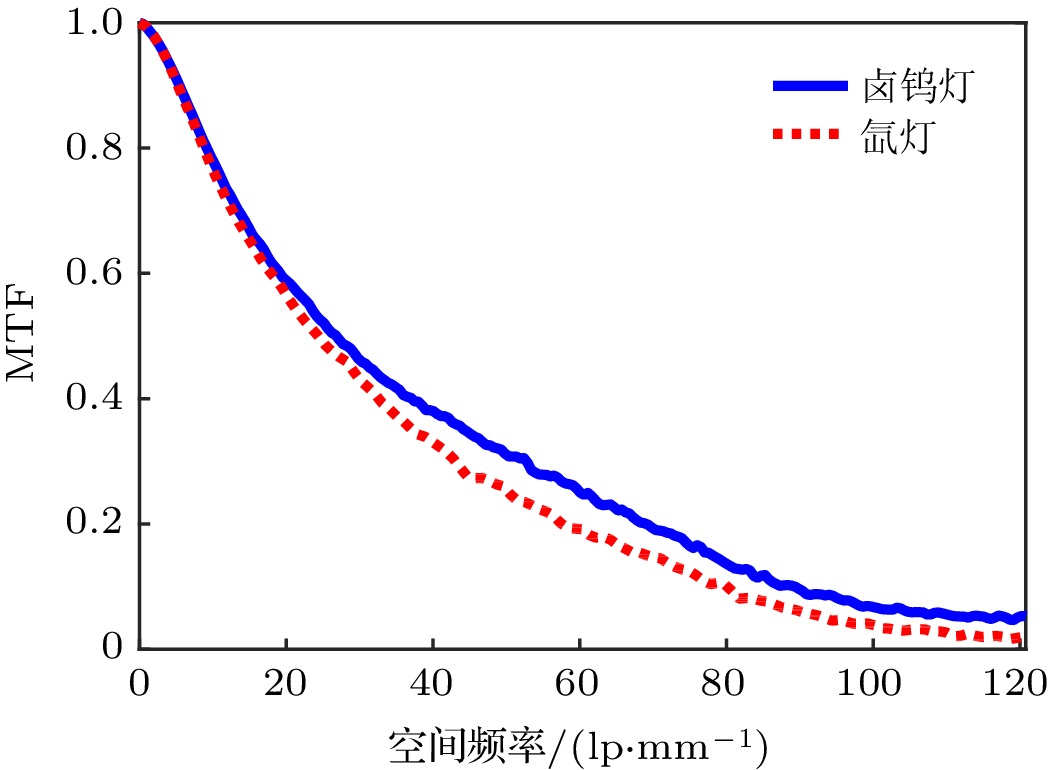 图 10 卤钨灯和氙灯光源MTF检测结果
图 10 卤钨灯和氙灯光源MTF检测结果Figure10. MTF measurement results with a tungsten halogen lamp and a xenon lamp.
为量化对比光源光谱特性对空间相机MTF的影响, 表2给出了采用卤钨灯和氙灯检测MTF时在







| 光源 | 不同空间频率处的MTF | |||
| ${f_c}/4$ | ${f_c}/2$ | $3{f_c}/4$ | ${f_c}$ | |
| 卤钨灯 | 0.460 | 0.248 | 0.091 | 0.053 |
| 氙灯 | 0.428 | 0.191 | 0.058 | 0.020 |
| 卤钨灯与氙灯 间MTF偏差 | 0.032 | 0.057 | 0.033 | 0.033 |
表2卤钨灯和氙灯光源所得MTF检测结果及其偏差
Table2.Test results and its deviation between the MTF measured with slanted-edge method by using a tungsten halogen lamp and a xenon lamp.
